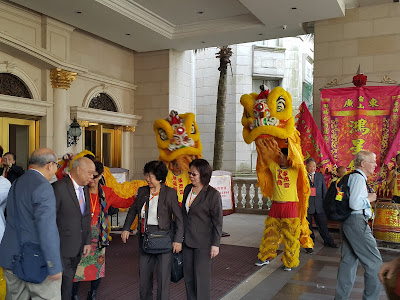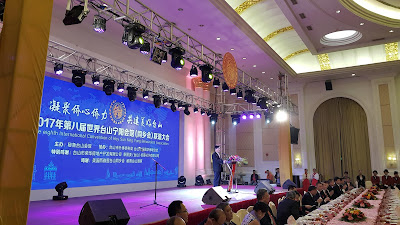 |
| 6 of us at the Toi Shan Convention |
Where do you come from? Very often we are asked this
question. It is not about the birds and the bees that you tell your children.
It is about what your roots are and where your ancestors come from.
My husband and I were keen to find our roots. Last year in 2017, my
husband’s cousin from Singapore invited us to join a group of Singaporeans (Ning
Yeung Wui Kuan) to go to Toi Shan, Guangdong Province in China, for a Toi Shan
Convention. As my husband’s family come from the town Toi Shan and they speak the Toi Shan dialect, this
was the golden opportunity to find out more about his roots.
So 4 of us from Malaysia (my husband and I, his sister and brother), my husband's cousin and wife. and the Singapore contingent flew to Toi Shan to attend the
International Convention (9 – 10 Nov 2017).
We arrived in Toi Shan on 8th November in
the evening. We checked in to the JOS Hotel and took a taxi to Phoenix Hotel for a delicious welcome dinner. The menu was mouth-watering with roast
goose, roast duck, chicken, cauliflower, bitter gourd soup, ma-ka herbal soup
and all varieties of dim sum for dessert.
 |
| Lobby of JOS Hotel |
Next morning (9th November), after a hearty breakfast, we were off
to the Phoenix Hotel again to attend the Convention.
 |
| A hearty breakfast |
Called Convention of Hoy Sun Ning Yung Association, (hoy sun is the local dialect) it was quite a grand affair. At the entrance, we could not hide our excitement at the charming decor. Everyone tried to capture some memorable photos.
 |
| 5 of us at the entrance |
 |
| Delegates taking memorable pictures at the entrance |
 |
Delegates taking memorable shots at the entrance
|
|
 |
| Map of Toi Shan |
 |
| Toi Shan Agriculture |
 |
| Toi Shan Industry |
 |
| Map of Guangdong |
Just outside the Convention Hall were congratulatory flowers and messages.
 |
| Flowers with congratulatory messages |
As we entered the Convention Hall, I was amazed to see a very
big crowd, about 900 people, greeting and chatting with one other. Most of the crowd were senior citizens. They come from different parts of the world and they were all conversing in the Toi Shan dialect!
 |
| About 900 people from different parts of the world |
This was the 8th International Convention.The organiser for the Convention, on a rotational
basis, was Peru, South America. The event was sponsored by Peru Hoy Sun Association and co-sponsored by Hoy Sun City Council.
From a
book distributed, the number of representatives from
each country was: United States (288), Canada (210), South America (77),
Singapore (49), China (27), Australia (26), Hong Kong (15), New Zealand (13), Myamar
(10), Malaysia (4), Taiwan (2) and others (5).
The Opening Ceremony started with a roar - a Lion
Dance. Amidst the beating of the drums, the lion dancers pranced up to the stage, causing ripples of excitement.
 |
| Lion dancers on stage |
Next, there was an introduction of the organisers and all countries' representatives. This was followed by China’s National Anthem.
As we enjoyed the many varieties of Guangdong cuisine, we exchanged ideas, and learned of each other's experiences in the countries they have migrated to.
 |
| Our table of 6 members with other Singapore delegates |
While we dined, an ongoing
variety show entertained us. Led by Chinese TV personalities, these included songs
and dances, both modern and classical, performed in Toi Shan dialect, Cantonese
and Mandarin. Some of these were: I am a
Toi Shan, I love you, Southern Sea and Meeting
in dreams.
 |
| Entertainment while we dined |
 |
| Entertainment while we dined |
After lunch, we went back to our hotel. In the evening, we went back to Phoenix Hotel for dinner and the second part of the programme.
The programme started with speeches
by the Peru organiser, Mayor of Toi Shan city, and the announcement of Vancouver,
the next conference organiser, scheduled to be in 2019. There was a “handing
over” of the next sponsorship just like in the Olympics.
 |
Handing over ceremony
|
Throughout
the dinner, there were musicals, group songs, solo, folk songs and dancing. Among
the items, many were famous Toi Shan celebrities. The last item was a group song
We belong to one family.
Dinner entertainment:
The programme ended with a photography session. The delegates moved up to the stage orderly when their country’s name was called, group by group. There was laughter and cheer as the individual groups arranged themselves, posed and smiled into the myriads of cameras focused on them from all angles.
 |
| Delegates from Singapore |
Next day (10th November), there was an organised tour of Toi Shan for all delegates. Our number was so big that we had to travel in 5 buses. The visits showcased the contribution and remembrance of Toi Shan migrants.
1. Mui Family Garden
This place, a setting for filming movies, had only a few rows of shophouse along a street.
It was quite deserted except for traders who were selling preserved vegetable, herbs, dried fruits, fried chicken, arrowroot and sweet dessert (sesame and beancurd). When we arrived, the whole place came alive, swarming with Toi Shan delegates!
 |
| With a Canadian couple in Mui Family Garden |
 |
| A trader selling dried foodstuff in Mui Family Garden |
2. Taishan Haikou Port
This Port and Memorial of Yinxin, Memory of the World showed Historic Trials of the Chinese emigrants and Memorial of Overseas Chinese. Historically, the Chinese who wished to migrate to overseas countries chose this Port to sail out of China.
The Memorials there were built by overseas Chinese who send money back to finance it.
 |
| The Port where emigrants sail out of China |
 |
| The Memorial |
 |
One memorial detailing the Chinese who migrated overseas
|
3. Chen Village.
The Chen family migrated to the United States and Canada. They returned to Toi Shan to build homes with foreign architecture. Now, they do not live there anymore.
 |
| The Chen Village |
 |
| Buildings with foreign architecture in Chen Village |
 |
| Homes with foreign architecture |
4. The Xinning Railway
The railway station is a 2-storey building of brick and concrete with stained-glass windows. Mr Chen Yixi (1844 - 1929) who migrated to Seattle in the early 20th century came back to Toi Shan to help modernise his hometown. He built this private railway (the first railway in China) with money he raised primarily from Chinese-Americans. There were statues, placards and a locomotive to commemorate this historical figure.
 |
| Mr Chen Yixi and the Railway system |
 |
| Railway Station with statue of Mr Chen Yixi and locomotive in background |
 |
| Our group of 6 with statues of people in the past |
5. Her Shan County Museum
 |
| Her Shan County Museum |
The most absorbing visit was Her Shan County Museum. The exhibits there showed how migrants struggled and survived overseas. There were also stories of those who were successful who came back to contribute to the development of Toi Shan, their fatherland, as well as to their homeland.
One story I found most interesting was how the overseas Chinese embrace their fatherland but love their homeland. It is quoted here:
"Generations of Toishanese left their villages. When abroad, they suffered discrimination, exclusion and oppression. Their arduous and brave efforts, however, eventually enabled them to persist for generation after generation. Together with the people of their countries of residence, they blazed new trials in industry and commerce, exploited natural resources, opposed colonialism and made indelible contributions to the economic development and social progress of the countries where they lived. Although they live overseas, the overseas Chinese both embrace their fatherland and love their homeland."
Some of the striking exhibits:
 |
| Brave emigrants sailing away and waving goodbye to family members |
 |
An immigrant panning for gold in a foreign country
|
 |
In the 19th century, some Toi Shan people
were abducted and signed up to work abroad |
 |
Toi Shan immigrants worked as farmers
in California in the 1880s |
 |
Mr Ou, a Toi Shan, became
"pineapple king" in Hawaii |
In between the visits, we had lunch at a restaurant with Toi Shan specialities. With about 900 of us, it was a merry and noisy lunch.
The Toi Shan specialities:
 |
| Salty Smoked fish with Chinese Sausage |
 |
| Steam chicken with kum cham (lily buds) |
 |
| Braised pork with lotus
root (leng ngau) |
 |
Porridge with boneless fish and lean pork
|
 |
Winter melon (Toong kua) soup
|
|
After the informative tour, we went back to Phoenix Hotel for another sumptuous dinner.
 |
Basket of healthy nuts (cashew,walnut, ginkgo) with vegetables
|
 |
Chicken soup
|
 |
Squid-sea cucumber (hoi sam)
-mushroom-broccoli dish
 |
Different varieties of Dessert
|
|
|
 |
Appetising Scallops
|
 |
| Basket of healthy nuts (cashew,walnut, ginkgo)with vegetables |
|
We were pleasantly surprised that all of us present (delegates) were given a set of souvenirs to take back.
 |
A set of souvenirs: jewellery box, maca herbs, cordyceps
and packets of pu'er tea with orange peel
|
All too soon, the two days of Toi Shan Convention and Tour came to an end. We bade farewell to new friends and hope to meet up again for the next Convention in 2019.
After the Convention, the 6 of us went to Sheung Moon Village in Toi Shan to find out more about my husband's ancestral village. A cousin of my husband's Singapore cousin who lives in Toi Shan, guided us there.
My husband and his siblings were delighted to see the home of their father and grandfather. The house is about 90 years old. Some of the furniture were still good and usable, which we would call antiques in this modern era.
 |
| Rice and corn field at the village |
 |
| Lane leading to ancestral house |
 |
| Entrance of grandfather and father's (Chia) ancestral home |
 |
| 6 of us with China relatives in the hall of Chia ancestral home |
 |
My husband (centre) with his sister and brother in their ancestral home
A ladder on the right leads to an altar for ancestral worship |
 |
| Kitchen of Ancestral home |
Visiting the humble abode of ancestors gave us a better perspective of how our parents and grandparents lived.
Attending the Toi Shan Convention and touring Toi Shan were great eye-openers. We discovered that the Toi Shan community is very large and that it has spread to all parts of the world.
We learned how our ancestors left the fatherland, how they struggled and suffered when they migrated to foreign countries to make a living. We learned how successful migrants returned to the fatherland to help develop it.
Attending the Toi Shan Conference and finding our roots was an enlightening and enriching experience.







































































